First Driving Impressions – Volkswagen Golf, International Press Launch, Sardinia
 The all-new Golf is the seventh generation, with the MK1 being introduced 38 years ago, making the average length of time for each model introduction being just over six years. However, the current version, the MK6, only managed to remain in production for just over 3 years, so the MK7 has arrived much earlier than any other new Golf.
The all-new Golf is the seventh generation, with the MK1 being introduced 38 years ago, making the average length of time for each model introduction being just over six years. However, the current version, the MK6, only managed to remain in production for just over 3 years, so the MK7 has arrived much earlier than any other new Golf.
Since its launch in 1974, over 29 million Golf models have been sold worldwide, with 1.6 million of them finding homes in the UK. Volkswagen has stayed close to their tradition of introducing the new Golf with evolutionary styling, as opposed to revolutionary, and it’s immediately clear when you see the new version that it is a Golf – there’s no doubt whatsoever; it’s instantly recognisable.
The exterior design has stronger swage lines running along the length of the car and around the boot lid, with tweaks here and there in certain areas, but the majority of changes are dimensional. The new model is 56mm longer, 13mm wider and 28mm lower than its predecessor. It has a longer wheelbase, as the front wheels have been moved forward by 43mm, which in turn has increased the interior space for occupants. The boot space has also seen an increase, from 350 litres to 380 litres with the rear seats up. Despite this increase in size, the car now weighs up to 100kg lighter – overall the body of the new car has shed a total of 23kg in weight. This loss of weight has contributed to the new Golf being up to 23% more fuel efficient.
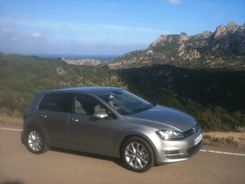 Under the surface, the use of the new MQB (Modular Querbaukasten) platform, or Modular Transfer Matrix, brings fundamental changes to the platform, and this system will be used more and more on VW Group products.
Under the surface, the use of the new MQB (Modular Querbaukasten) platform, or Modular Transfer Matrix, brings fundamental changes to the platform, and this system will be used more and more on VW Group products.
At launch, the following engines will be available: a 1.2 litre TSI 85ps petrol; a 1.2 litre TSI 105ps petrol; a 1.4 litre TSI 122ps petrol; a 1.4 litre TSI 140ps petrol with Active Cylinder Technology; a 1.6 litre TDI 105ps diesel; a 1.6 litre TDI 110ps and a 2.0 litre TDI 150ps diesel. Bluemotion Technology will feature on all engines except the 1.6 litre TDI 110ps diesel. A 1.6 litre TDI 110ps diesel with Bluemotion Technology is planned for the future, which will have CO2 emissions of just 85g/km and a combined fuel figure of 88.3 MPG.
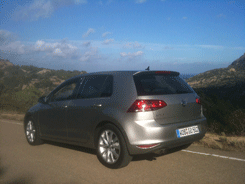 Three specification levels will be offered at launch in the UK: S, SE and GT, and these will be available in both three and five door body styles. A GTI version is planned and this will be powered by a 2.0 litre TSI 220ps petrol engine. The cars we drove in Sardinia were Highline models, which are similar to the GT trims, and only the 1.4 litre 140ps petrol and 2.0 litre TDI 150ps diesel were available to test drive.
Three specification levels will be offered at launch in the UK: S, SE and GT, and these will be available in both three and five door body styles. A GTI version is planned and this will be powered by a 2.0 litre TSI 220ps petrol engine. The cars we drove in Sardinia were Highline models, which are similar to the GT trims, and only the 1.4 litre 140ps petrol and 2.0 litre TDI 150ps diesel were available to test drive.
Volkswagen chose Northern Sardinia for the international press launch because of the fantastic roads the island has to offer. This part of the world is lacking in motorways and dual carriageways, so top speed was not the idea of the launch – it was more a way of testing the car’s characteristics on quiet, twisty roads in the sunshine, and a chance to get out of the car and have a really good look around it.
The new Golf is without doubt still a Golf in terms of its design, which is not a bad thing at all.
Out on the road it behaved perfectly; it’s so quiet, with no rattles, squeaks, wind noise, road noise or engine noise to be heard. The car’s handling is also brilliant; everyone loved it on the event. Just going on motorways or at high speeds would have been enjoyable, but the new Golf was so at home going up into the hills and around the small villages. This sort of journey is what the Golf is good at and VW know it. The chosen routes certainly did the car justice and there were some wonderful sights to take in whilst sat in a car with all the latest safety technology. I felt very safe in the new Golf, as it was so solid on the road.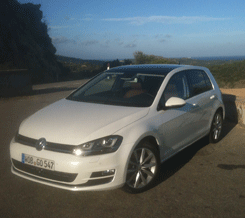
As mentioned above, the 1.4 litre TSI 140ps petrol engine has Active Cylinder Technology, which can go from using 4 cylinders to 2, in conditions when only two are needed. And even though there’s a small indicator in between the two round dials on the dash that actually shows you whether it’s running on 2 cylinders or 4, you don’t know whether to believe it or not as you cannot spot the difference! It’s very clever stuff…and it saves you money too.
One of the first things we wanted to find out is just how much more room had been created in the rear as a result of the dimension changes. It is noticeably roomier when you sit in the back and headroom has not been compromised by the slight lowering of the roof, so it’s a much more relaxed place to sit. Comfort is very important to everyone, but one of the cars we drove seemed to lack it a little, as it had leather upholstery which seemed very firm – someone even described it as hard – and you felt as though you were sitting on the seats as opposed to sitting in them. Maybe in time the leather will give a little and make the seats more comfortable. The car which had cloth seats was still a bit firm, but certainly more acceptable.
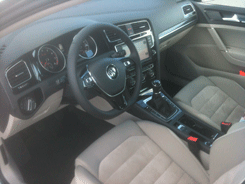 The first thing you look at when getting into any car, or the first thing you touch, is the steering wheel. I have to say that the steering wheel on the new Golf just feels too large in diameter. I’m sure it’s probably the same size steering wheel as all the models preceding it, but somehow it just felt a bit out of proportion in the MK7.
The first thing you look at when getting into any car, or the first thing you touch, is the steering wheel. I have to say that the steering wheel on the new Golf just feels too large in diameter. I’m sure it’s probably the same size steering wheel as all the models preceding it, but somehow it just felt a bit out of proportion in the MK7.
One clever aspect is the fact that you can store the rear parcel shelf under the variable load floor, so if you have a tall or large item to carry, you simply take off the parcel shelf and put it under the floor out of the way. The variable floor can either be placed at bumper level for easy loading, or it can be lowered to provide extra space.
As far as changes to the interior go, the centre console and dash are now orienteered towards the driver, as opposed to being flat on towards both driver and passenger. This new design looks more stylish and does help the driver in being able to see the instruments easily, especially features such as the sat nav screen. Another change is the manual handbrake – it’s now a thing of the past in the Golf, as the new model gets an electronic parking brake as standard.
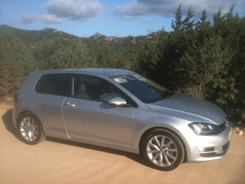 The new Golf is without doubt still a Golf in terms of its design, which is not a bad thing at all. It provides more room, has some intelligent features throughout and has a good choice of economical engines available. This Golf, like every Golf before it, will have a successor and there’s no doubt that the MK8 will be an improvement on the 7, but for now, any customer buying the latest Golf is assured of high quality throughout, reliability and a high used car selling price, so nothing changes.
The new Golf is without doubt still a Golf in terms of its design, which is not a bad thing at all. It provides more room, has some intelligent features throughout and has a good choice of economical engines available. This Golf, like every Golf before it, will have a successor and there’s no doubt that the MK8 will be an improvement on the 7, but for now, any customer buying the latest Golf is assured of high quality throughout, reliability and a high used car selling price, so nothing changes.
Prices for the new Golf start from £16,330 and go up to £24,625. The 5 door costs £655 more than the 3 door. First deliveries are due in the UK from January 2013.
Volkswagen UK expect to sell around 60,000 units per year to both private and fleet buyers. All of these cars will then hit the used cars market, and all will easily find a second, third and fourth home, just as they always have. So again, nothing changes and the cycle of the ever popular Golf continues.





